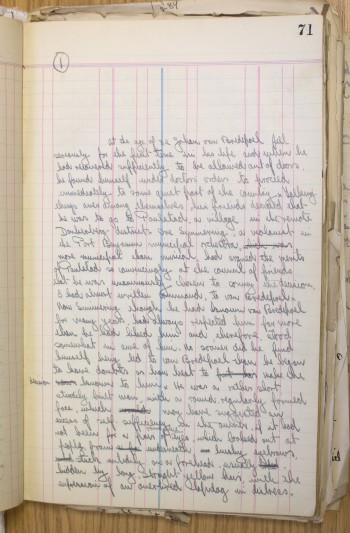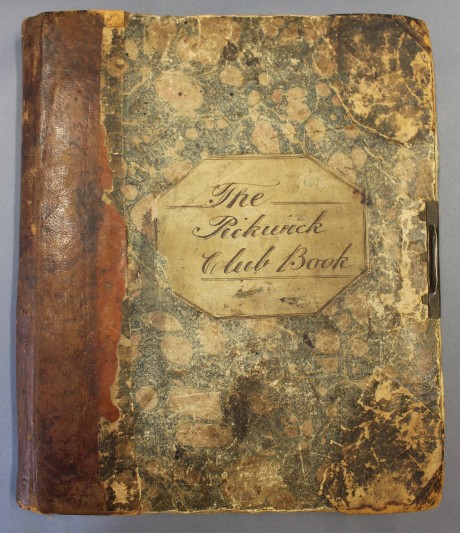This large archive of several hundred letters, notecards, etc., circa 1898-1948, largely comprising large bundles of autograph letters to Sydney Cockerell, or Wilfred Scawen Blunt. Their appeal to the Fitzwilliam Museum was obvious. We house the largest single archive of works by and associated with Wilfrid Scawen Blunt (1840-1922) in the world (including Blunt's original diaries, autograph drafts of his major poems and other published works, and much other completely unpublished manuscript material), and it is one of our most frequently consulted collections. Moreover, Sydney Cockerell (1867-1962) was the longest-serving and arguably most influential Director of the Fitzwilliam Museum (1908-37), as well as secretary, adviser and executor to Wilfred Scawen Blunt. With the generous and remarkably speedy assistance of the Friends of the National Libraries, we were able to bid and acquire the archive.
Search FNL grants since 1931
Written by a single hand in a typically Italian Rotunda script of preternatural regularity, the elegance of which is enhanced by still-wide margins, this late 15th century Book of Hours (Use of Rome) is a handsome and engaging volume. Though robbed of the incipits for Matins and the Hours of the Cross, it preserves large decorated initials plus elaborate border ornament at all the other major textual divisions, plus countless smaller decorated initials throughout. An invaluable addition to our holdings, within three days of arriving in Durham it had already featured in a display class, highlighting its importance here as an excellent example of Italian script, decoration and book production, and as a fascinating complement to our other devotional books and horae, almost all of which are from north of the Alps.
Sir Gilbert Clayton was a distinguished soldier and diplomat, serving in North Africa and the Middle East. He excelled as the director of military intelligence in Cairo during the First World War, particularly in managing those military operations in the Hijāz which brought T. E. Lawrence to world attention. That he kept Lawrence’s high regard says a great deal: ‘Clayton made the perfect leader for such a band of wild men as we were. He was calm, detached, clear-sighted, of unconscious courage in assuming responsibility. He gave an open run to his subordinates. His own views were general, like his knowledge; and he worked by influence rather than by loud direction. It was not easy to descry his influence. He was like water, or permeating oil, creeping silently and insistently through everything. It was not possible to say where Clayton was and was not, and how much really belonged to him. He never visibly led; but his ideas were abreast of those who did: he impressed men by his sobriety, and by a certain quiet and stately moderation of hope. In practical matters he was loose, irregular, untidy, a man with whom independent men could bear’ (Seven Pillars of Wisdom, 1936, p. 57). After the war Clayton served as High Commissioner in Palestine and brokered a series of border agreements across the region, but his career was cut short when he died suddenly, having just taken up the post of High Commissioner in Iraq.
Laurens van der Post was one of the most important and influential literary figures of the 20th century. The collection is perhaps unique, in that van der Post was directly or indirectly involved in many of the key literary and political developments of the period. The papers reflect his long, extraordinary and occasionally controversial life. The papers catalogued so far include correspondence relating to his involvement in the literary circles of the 1920s and 1930s, most notably a series of surprisingly revealing letters from the reactionary South African poet and occasional bull-fighter Roy Campbell, whose attacks on the Bloomsbury set and their effeminate nature are as entertaining as they are informative.
This is a hard-backed, handwritten notebook, filled in by a group of men who gathered regularly in a London pub to debate local, national and international current events, trade in banter and discuss literature and cultural matters. Modelling themselves on the club described in Charles Dickens’s The Pickwick Papers, published in monthly parts from March 1836 to November 1837, the members adopted the names of the club’s fictional characters and embodied similar characteristics of the original Pickwickians, celebrating the convivial and humorous spirit of the club and characters. The cultural history of Dickens clubs, the consumption of the novelist’s works, the significance of Dickensian characters beyond the novels, and the greater story of early Victorian London are all themes represented in a profound way within this fascinating book, which ran concurrently with the publication of the monthly parts for nearly a year. It is by far the earliest record of a Dickens club and enhances other items in the Museum’s collection relating to Dickensian interest groups, for example, the Pickwick Bicycle Club (est. 1870), the Dickens Fellowship (est. 1902), the Boz Club (est. 1900) and the Uncommercial Travellers’ Club (est. 1920s).
Dickens always took an interest in the way his readers made use of his stories and particularly delighted in these groups. In 1837, he wrote to the newly-formed Edinburgh Pickwick Club, exclaiming, ‘I cannot tell you how much delight it has afforded me to hear of its existence… Mr Pickwick’s heart is among you always’ (this letter is also in the Museum’s collection).
A small but fascinating archive of notes and drawings by the painter Charles Mahoney (1903-1968), mostly relating to the murals in the Lady Chapel of Campion Hall, subsidised by Evelyn Waugh, and painted in 1942-52. There is also one sketch in the hand of Sir Edwin Lutyens of an early project for the completion of the projected quadrangle of buildings at Campion Hall and Mahoney has drawn details of drapery on the same sheet, rendering it a compelling record of hopes for the future as envisaged at the end of the 1930s. The Master of Campion Hall, Martin D’Arcy SJ (1888-1976) had chosen Mahoney as the mural painter for the Lady Chapel with the advice of Sir John Rothenstein, after Stanley Spencer (the first choice) had proved too disruptive a personality to work in the Hall over a long period. This archive documents not only the evolution of the mural paintings, but also offers valuable sketches and observations of the daily life of the Hall in the 1940s and early 1950s. As such it complements perfectly the substantial holding of Mahoney letters from the same period already in the archives.
The parish library at Lund was established by the gift of Sir Thomas Remington (c.1612‒81), possibly in or shortly before 1676, when this catalogue was made. Though sadly the contents of the library were dispersed in the 19th century, this unique and very detailed catalogue—numbering over 160 pages and probably written by Remington himself—opens a window onto the literary world of 17th century Yorkshire. Catalogues such as this are rare and the books at Lund Church formed an impressive collection, whether it be considered a private or public library.
One of the most important art collections in Britain of the 17th century was that of Thomas Howard, 8th Earl of Pembroke (1656-1733) (of Pope’s ‘statues, dirty gods, and coins’ fame). He had a particularly strong collection of coins, and his is the best documented of any early British coin collection. In 1746 Numismata Pembrochiana was published, consisting solely of over 300 plates. It is attributed to Nicola Haym, author of Il Tesoro Britannico (1719-20), an account of the previously unknown ancient coins in English collections, including that of Pembroke. Haym, who is probably better known as the librettist of several of Handel’s operas, was planning to publish a more substantial book on numismatics, but was prevented from doing so by his death in 1729. The 1746 book was published many years after the death of Haym, but something is known of an earlier history of the volume from the correspondence of William Stukeley. He records on 2 December 1732 spending ‘Tuesday night with old Carvilius [Pembroke]’, who ‘showed me all his medalls engraved in 5 large vols qto upon 300 plates, a most surprising sight for number and value’. Stukeley relates how they ‘were all drawn by Signor Haym’s own hand’, and how after Haym’s death some of the plates were lost and others destroyed by his widow. A very few ‘proofs’ of the early version have been discovered, all in private hands until now. Two have a single additional title page signed by Haym, but two others contain extensive additional written material, mostly written on the printing plates, but some added by hand. Thanks to the generosity of the Friends of the National Libraries, one of these has now been acquired by the British Museum. It is an important addition to the Museum’s world-class collection of antiquarian numismatic books.
The Red Book, a record of the work undertaken by Baron Ferdinand Rothschild (1839-1898) at Waddesdon Manor, his neo-Renaissance mansion near Aylesbury. Copies of this private publication are extremely rare—this is only the sixth recorded. Dating from1897, the Red Book opens with an introduction by Baron Ferdinand, followed by a series of invaluable photographs detailing the various rooms and the collections displayed with such artistry within them. Particular attention is paid to the New Smoking Room, which Baron Ferdinand designed to display his ‘Renaissance Museu’, a treasury which had a special role in his mind as a collector. He bequeathed the contents of this room to the British Museum under the terms of his will, to be known as ‘The Waddesdon Bequest’. The Bequest has been on permanent display in the British Museum since 1899, and in June 2016, was redisplayed in a splendid new gallery in the old Middle Room of the British Museum, funded by the Rothschild Foundation.
This autograph letter with envelope from the composer Gustav Holst (1874-1934) is addressed to Mrs Bell, wife of the Bishop of Chichester. The Museum did not previously not have any letters associated with Bishop Bell, who was a great friend of Gustav Holst. Holst was eventually buried at Chichester Cathedral, which makes this connection even more significant. George Kennedy Allen Bell (1883-1958) was an Anglican theologian, Dean of Canterbury (1925-29), Bishop of Chichester, member of the House of Lords and a pioneer of the Ecumenical Movement. As Dean of Canterbury, he initiated the Canterbury Festival of the Arts, with guest artists such as John Masefield, Gustav Holst, Dorothy L. Sayers and T. S. Eliot.


